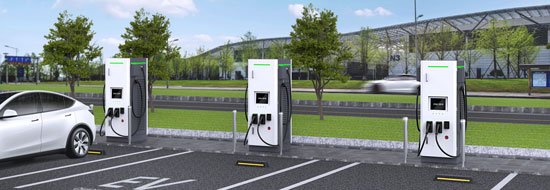Australian research has found EV charging facilities offered free using optimised solar systems can lower grid demand in the evening, with implications for broader nation-wide efficiencies.
Engineering researchers based at the University of South Australia (UniSA) Mawson Lakes campus say that using renewable energy to power EV day charging is key to lowering electricity grid demand in the evening and helping to support Australia’s net zero emission targets by 2050.
UniSA’s Mahfuz Aziz, Mohammed Haque and UniSA PhD researcher Yan Wu published their peer-reviewed findings in the Renewable Energy journal, in December last year.
The EV charging facility model addresses South Australia’s very high rate of PV penetration, driving high solar generation during the day, leading to substantial decrease in grid power demand around midday and a dramatic increase in grid demand during the evening when solar generation falls.
“This causes significant operational challenges as excess power generated by rooftop solar and exported to the grid creates major grid issues as dispatchable power must be ramped up suddenly to replace dwindling solar power later in the day, causing a so-called duck curve,” Aziz said.
“Workplace charging of EVs helps address this challenge by using excess renewable generation during the day. Prioritising daytime workplace charging reduces pressure on the grid during the evening peak hours by decreasing the demand for home charging of EVs,” Aziz said.
The study anticipates a dramatic increase in EV vehicles requiring charge stations in Australia by 2050, which according to the 2021 EV Opportunity Assessment Report and the Australian Electric Vehicle Market Study, will increase from the 25% target by 2030 to more than 80%, with the ACT planning to ban the sale of new fossil fuel-based cars by 2035.
Haque said Australia would use solar more efficiently if it established comparable EV charging infrastructure proposed by the study, in private and public facilities.
“This initiative not only helps in achieving a more balanced grid demand profile, but also promotes a greener environment,” Haque said.
Yan Wu explained the research looked at different models to determine the most efficient way to support electric vehicle charging, while decreasing the campus’s net annual energy costs. The researchers found that at 25% EV penetration, the UniSA Mawson Lakes campus could reduce its annual electricity costs by more than 9% by upgrading its existing solar systems to optimum capacity, supporting free EV charging during the day, and helping to lower peak power demand by at least 12%.
“By optimising the PV system, more energy would be exported to the grid, which does not attract any revenue. However, providing EV charging services at a nominal fee using the excess PV generation is a sensible solution,” Yan Wu said.
“By doing so, the campus can potentially support 800 EV cars, the maximum number of parking spaces at Mawson Lakes, while incurring almost the same annual energy costs as that for 25% penetration with free charging.”
The researchers used data from the Victorian Integrated Survey of Travel and Activity (VISTA) to obtain average daily travel distances and campus arrival/departure times. The modelling based on this data was further validated using actual parking data from Monash University’s Clayton campus.
The campus currently has rooftop solar systems on 18 buildings, supplemented by ground-mounted solar installed in 2019 based on energy needs at that time, but prior to the rapid uptake of electric vehicles.
According to the Global EV Outlook 2023, worldwide sales of electric vehicles almost doubled in 2022 compared to 2021, with more than 26 million EVs sold representing a 60% increase on 2021 and more than 500% higher than in 2018.
This content is protected by copyright and may not be reused. If you want to cooperate with us and would like to reuse some of our content, please contact: editors@pv-magazine.com.
[ad_2]
Source link




